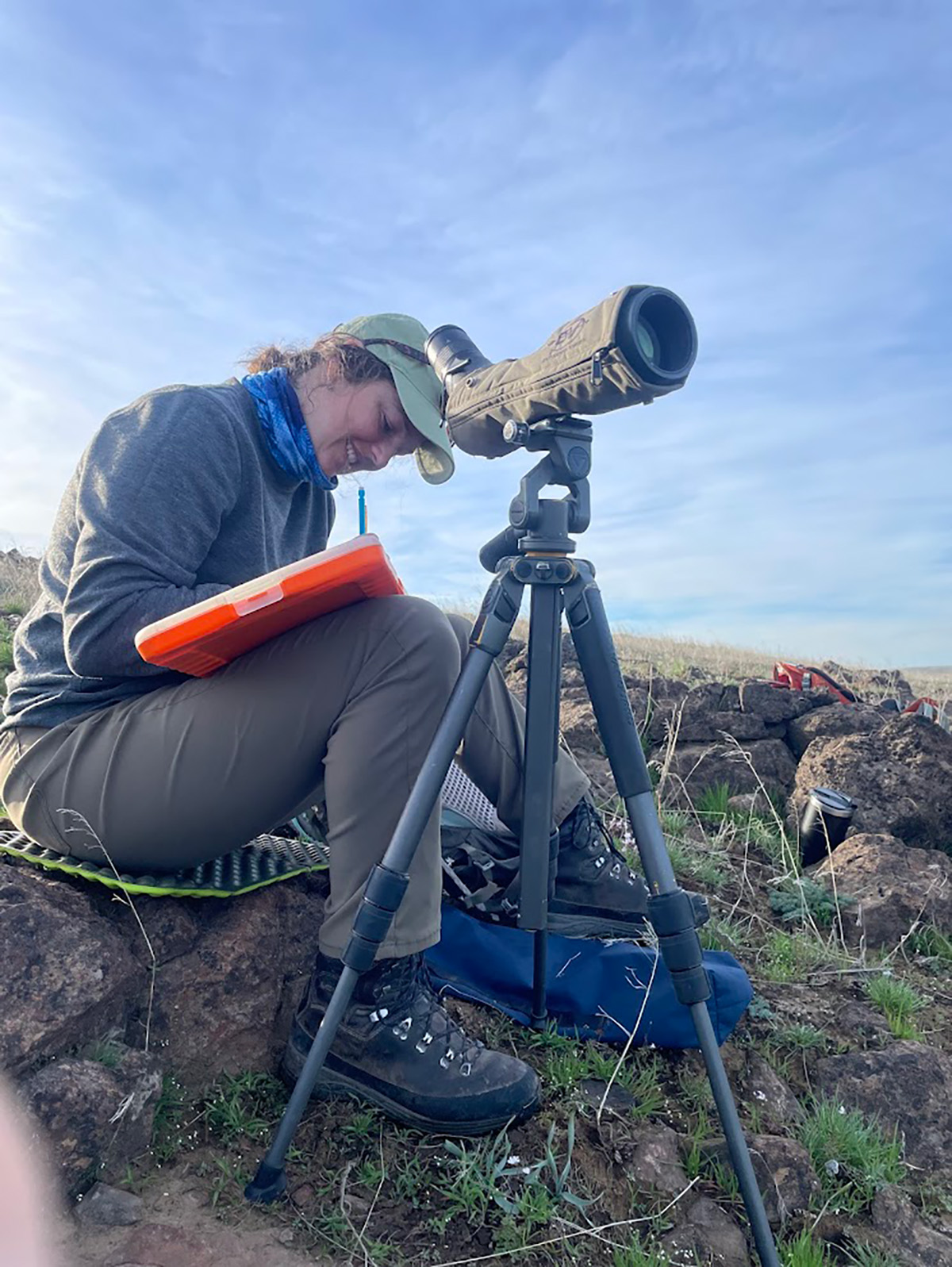U of I students uncover why bighorn sheep thrive disease-free in John Day
U of I researchers look to diet and nursery groups as possible causes for bighorn sheep success
Bighorn sheep are a well-known symbol of the American West’s wild places, but managing for healthy, disease-free wild sheep populations has proven difficult across their range, including in the steep canyons of the Snake River between Idaho and Oregon.
The Nez Perce tribe used bighorns for food, hides and horns, and petroglyphs along the Snake River depict wild sheep and hunters. By the early 1900s, though, bighorn sheep were almost eliminated in large part because of disease — often pneumonia — introduced by domestic sheep.
Decades-long efforts by biologists to bolster herds have had mixed results. There is, however, a population of these wild ovines that are disease-free and thriving despite ecological changes in its north-central Oregon landscape.
The bighorns that live in the canyons of the John Day River were reintroduced about 35 years ago. They now thrive in the main river canyon and its tributaries, while populations elsewhere have struggled.
“The John Day River bighorn sheep population is one of the greatest translocation success stories in the history of the species,” said Ryan Long, associate professor of wildlife sciences at U of I.
Two of Long’s graduate students, Emily Lowrimore and Alexis Means, are exploring reasons why the herd of more than 1,000 individuals that roam the slanted ground along the John Day River is prospering. Lowrimore and Means are now in their second season studying John Day’s bighorns, collecting data to learn why this herd remains healthy and stable.

John Day Canyon bighorn sheep project with ODFW & University of Idaho
The John Day River Canyon is home to one of Oregon’s healthiest bighorn sheep populations—but why? Researchers are on a mission to find out. Since disease is the leading cause of bighorn sheep deaths across North America, understanding what makes this herd so resilient could help protect others. ODFW and the University of Idaho teamed up for a two-year study to explore how nutrition affects these sheep. Watch as graduate students and wildlife biologists collaborate with a helicopter crew to capture bighorn sheep, collect vital data, and release them with GPS collars to track their movements.
“We’re trying to understand the different contributing factors that make this population of bighorns so healthy, and to learn if we can apply those qualities to other populations that may be struggling with disease or just population numbers in general,” Lowrimore said.
The two researchers study how food sources influence behavior and survival without the confounding influence of pneumonia — one of the diseases often affecting wild sheep populations.
Means’ research explores whether forage — what bighorn sheep eat — is among the factors keeping the herd fit and resilient, while Lowrimore is studying survival rates of the John Day herd and behavioral factors such as group dynamics that may influence survival.
Lowrimore hypothesizes that sheep in large groups may have an advantage against predation.
“The larger the groups are, the better it seems their chance of surviving,” Lowrimore said.
So far, her research indicates that individuals in large nursery groups, which are made up of ewes and lambs that gather in the spring and summer, have higher survival rates than individuals in smaller nursery groups.
Nursery groups in the John Day may comprise 80 sheep, whereas nursery groups in the less healthy Snake River herds often contain around 20 sheep.
“In larger nursery groups the more eyes there may be more eyes looking out for danger,” Lowrimore said. “Individual sheep can feed more freely as other sheep stand guard which allows sheep to alternate between keeping watch and eating.”
There’s actually a significant gap in knowledge on how much nourishment bighorn sheep need. Alexis Means, graduate student
Taking turns looking for danger or eating allows foraging sheep to relax their vigilance and forage longer, which can lead to increased survival for eses and lambs.
Food availability and nutritional value are also being assessed for their role in keeping sheep healthy.
“Grasses, grasses and more grasses,” said Means, who monitors what foods the John Day herd prefers at different seasons. “Much of the area is overrun with invasive plants such as cheat grass. When it’s small and green this grass can provide a really good food source before it dries up.”

Cheat grass is a rich nutrient staple for John Day’s herd in the spring but because it turns to brittle tinder in summer, the invasive cheat grass is prone to fire. Often, wildlife managers seek to replace the non-endemic grass with high-nutrient native grasses after fires char an area.
“There’s actually a significant gap in knowledge on how much nourishment bighorn sheep need to survive and thrive,” Means said. “We want to get better estimates of what sheep are selecting for in the John Day to meet nutritional requirements.”
The goal is to learn how the sheep transition from one food source to another and from one season to the next.
Learning more about what makes the John Day population tick, from what foods they eat to behavioral aspects, allows researchers to provide other agencies with information they can use to inform bighorn management decisions.
“It’s useful to understand what are the factors that limit populations like this in the absence of disease,” Long said.
Lowrimore, who grew up in an outdoor-oriented family in Utah, had originally planned to be a veterinarian until she learned she could earn a degree by studying wild animals outside.
“I was sold,” she said.
Means grew up in Nampa, also in a family that loved the outdoors. She attended college set on a dental career but quickly decided that having her fingers in another person’s mouth was not appealing. She switched her major to ecology and started working on Idaho Fish and Game projects.
To study bighorns, the graduate student researchers hike, climb and drive to remote locations in the John Day. They spend nights in remote field housing at the bottom on the canyon near the river.
To track and observe the bighorns the researchers have found glassing points along canyon rims that afford a wide view of the surrounding area.
“Some days we’re hiking up and down the canyons trying to locate sheep, while on other days we can sit on a rim and watch them for hours,” Lowrimore said.
After spending days following and observing sheep, returning to the cabin is a respite from the often hot, windy slopes.
“Any time we can end the day with a dip in the river is a good day,” Means said.

Article by Ralph Bartholdt, University Communications and Marketing
Photos by Melissa Hartley, University of Idaho Visual Productions, Alexis Means and Emily Lowrimore, College of Natural Resources
Video by Oregon Fish and Wildlife









